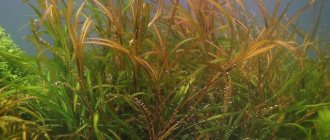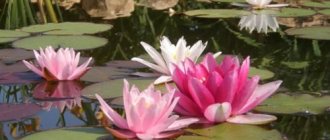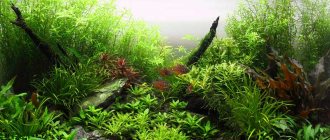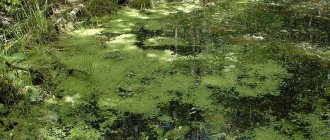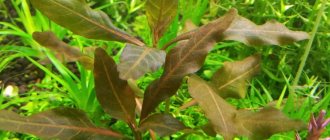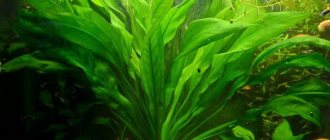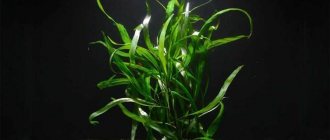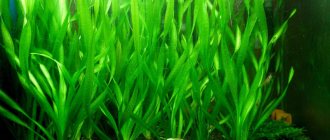Recently, it has become very fashionable among gardeners to create mini-reservoirs in their garden plots: ponds, lakes, and other waterways. It goes without saying that in this case one cannot do without coastal aquatic vegetation, because it is the main decoration of reservoirs. There are many thousands of species of plants living in water, but not all of them are suitable for growing in the middle zone. On this page you will learn the names of aquatic flowers and plants of the coastal zone, adapted to our conditions. You can also get acquainted with the description of aquatic plants and see their photographs.
Where do they grow
Few people think about it, but algae live almost everywhere where there is water - from small streams and swamps to huge oceans. Some species thrive in fresh water, while others prefer salty sea water.
But still, shallow waters and areas off the coast are most densely populated. The algae growing here receives the most benefits. On the one hand, there is enough sunlight needed for photosynthesis. On the other hand, the water warms up well and all living organisms, from tiny single-celled organisms to fish, act as actively as possible, releasing the carbon dioxide needed by the algae. With all this, it is possible to gain a foothold in the soil, receiving from it substances important for successful development. However, it is worth considering that not all aquatic plants take advantage of this opportunity. Many people prefer to either live on the surface of the water, or simply drift in the depths, never in their lives contacting the bottom and certainly not trying to gain a foothold in it.
The size of algae also varies greatly. Some cannot be seen without a microscope, while others can be tens of meters long. And all these underwater plants have names and detailed descriptions compiled by experienced biologists. Of course, it is simply impossible to talk about everyone - even the simplest algae deserves to have a book written about it. By the way, such an event actually took place in history. For example, connoisseurs are familiar with Konstantin Balmont’s book “Underwater Plants.” Of course, here he was looking at algae from the point of view of a poet, not a biologist. But such attention already says a lot.
Beautiful aquatic plants: TOP 7 best flowers for ponds
Lakes and ponds with beautiful aquatic plants present a mesmerizing sight. This is the real magic of water flowers. Looking at this beauty of reservoirs, you can forget about all your problems for a while. Below are the most beautiful aquatic plants and the best flowers for ponds, which can also be planted in a home pond on a personal plot.
Hydrocleis water lily
This beautiful aquatic plant native to South America is better known as water poppy. It features dark green, rounded leaves and colorful lemon-yellow flowers with a red-brown center. Due to its decorative appeal, water lily hydroclay can be an excellent floral decoration for a home pond or water garden on a personal plot.
Water poppy grows easily in shallow ponds with standing water. It needs good sunlight to grow successfully. On the surface of a reservoir, this beautiful aquatic plant grows up to 46 cm and rises above the water at a height of up to 15 cm.
The colorful lemon-yellow blooms of this aquatic flower can be admired in the summer. Flowers bloom for only one day, but water poppies bloom repeatedly, so their colorful flowers can serve as a decorative decoration for a pond all summer long.
Broadleaf arrowhead
This beautiful perennial aquatic plant is distinguished by its characteristic wide, arrowhead-shaped leaves, for which it received its species name. Arrowhead broadleaf blooms with beautiful white flowers. Three or more flowers can be arranged in a ring on one stem.
This beautiful aquatic plant grows well in streams, shallow waters and marshes. It is also known as duck potato.
The stems of broadleaf arrowhead can rise 0.6-1.2 m above the water. The plant grows in colonies in partial shade. Beautiful white flowers bloom from July to September. The seedless flowers are distinguished by the presence of attractive yellow stamens in the center.
Pontederia cordifolia
This deciduous perennial aquatic plant is widespread in America, where it grows in streams, ponds and swamps. It features long, glossy, heart-shaped leaves and tiny tubular blue flowers.
The stems of Pontederia cordifolia rise 30-60 cm above the water, and its leaves grow up to 25 cm in length. Beautiful blue flowers bloom from June to October. Their flowering will not only give a decorative appeal to the water garden at their summer cottage, but will also attract beautiful butterflies to it.
This is interesting! On the pages of the “Wings of Inspiration” project you can also learn about the most beautiful and rarest flowers in the world.
Aponogeton bispica (water hawthorn)
This plant is distinguished by tiny snow-white flowers with a very pleasant aroma, reminiscent of vanilla. Long narrow floating leaves also give it decorative appeal.
This is one of the best aquatic plants for ornamental ponds. Aponogeton bispica is also used as an aquarium plant.
Water hawthorn can grow up to 10 cm and the diameter of its spread on the water surface can reach 60-90 cm. This aquatic plant blooms twice a year, from mid-spring to mid-summer, and re-blooming is observed in winter.
Eichornia excellent (Water hyacinth)
This beautiful aquatic perennial plant is native to the South American tropics. It grows well in ponds, lakes and ditches. Water hyacinths are known for their thick, glossy, rounded leaves and colorful flowers ranging from blue to purple.
Eichornia excellent can rise above the water to a height of up to 1 meter, and its leaves reach 10-20 cm in diameter. The stem of water hyacinth is long and porous. This aquatic plant blooms in summer and fall, producing spikes of attractive blue-violet flowers with six petals.
Lotus
This is one of the most popular and most beautiful water flowers, most often used in ornamental ponds and water gardens. Buddhists consider this plant sacred. Lotuses grow in shallow reservoirs and lakes, but not in cold climates. They vitally need direct sunlight.
Like water lilies, lotuses take root in the mud of ponds or lakes where they grow, and their leaves and flowers float on the water surface. The leaves of these aquatic plants grow up to 50 cm in length, and their flower diameter can reach 20 cm.
You can admire lotus blossoms from June to mid-August. Attractive white or pink flowers open in the morning and close in the evening. Possessing a beautiful appearance, they also have a pleasant fruity aroma.
Water lily
Nymphea or water lily is the most beautiful water flower, distinguished by a wide variety of types and colors of petals. There are 70 species of water lilies in the world. These beautiful aquatic plants grow in ponds, ditches and other shallow bodies of water in tropical and temperate latitudes around the world.
Water lilies are characterized by wide, rounded leaves and colorful flowers. These plants take root in the soil of the reservoir where they grow. Their long underwater stem is connected to flowers and large leaves floating on the surface of the water.
The color of water lily flowers can be completely different. Among their main colors are white, pink, yellow, peach, red, purple and orange.
Victoria regia, native to the Amazon River basin, is the largest water lily in the world. Its perfectly round leaves reach 1.22-1.83 m in diameter, and its flowers are distinguished by the presence of 50-60 petals.
Water lilies bloom from spring to late autumn. The colorful and fragrant flowers of water lilies open only in the mornings or late evenings. This plant also protects the pond or any other body of water where it grows, providing shelter for many fish and invertebrates.
On a note! On our website you can also get acquainted with the most beautiful winter flowers, unusual types of orchids and the most expensive cacti in the world.
Main groups of algae
In general, there are many systems that involve dividing plants of the underwater world into groups. It will be quite difficult to list everything. Therefore, we will focus on one of the simplest ones. It provides for the separation of algae according to their place of growth:
- Coastal. They grow in coastal areas, at shallow depths. Only the lower part of the plant is under water, while most of it is above water. These include reeds, reeds, cattails, horsetails, and arrowheads.
- Aquatic. Algae that do not even attach to the bottom, preferring to spend their entire life in the water column, sometimes rising and sometimes falling, traveling with the current. These are hornwort, nitella, water moss, hara and others.
- Floating. Plants that live only in water, but at the same time stay exclusively on the surface. Some have a powerful root system, while others are practically devoid of it. Of course, they are not fixed in the soil, absorbing the necessary substances directly from the water. This group includes pistia, water buttercup, water chestnut, water kras, duckweed, marsh flower and a number of others.
- Submerged (aka deep-sea). Algae that take root in the soil with the help of long roots, but at the same time expose the main part of themselves to the surface. When listing them, first of all it is worth mentioning the lotus, water lily, egg pods, and orontium.
As you can see, even such a simple system is quite ambiguous - it is not always possible to say exactly which group a particular underwater plant of the ocean, river or tiny stream belongs to. Needless to say, nature is fraught with many amazing mysteries.
How to tell about everything? Perhaps this is simply impossible. Even if you describe underwater plants as briefly as possible, indicating names and photos, you will have to compile a whole book. Therefore, we will limit ourselves to just a few. Some are simply of particular interest, standing out from the standard series. And others are most often found in our country, so every lover of plants and wildlife in general should know about them. And of course, when describing underwater plants, we will attach photos so that the reader can get a more reliable impression of them.
Perennial aquatic flowers and ornamental herbaceous plants
Aquatic flowers and plants are a real decoration of ponds. But herbaceous aquatic plants are no less interesting, attracting attention with their rich greenery.
Arrow leaf (SAGITTARIA). Chastukhov family.
These are aquatic flowers, which are rhizomatous perennials, rooted at a depth of 10-50 cm. The leaves are dark green, shiny, dense. Flowers in inflorescence are a sparse raceme.
Types and varieties:
Broad-leaved arrowhead (S. LatifoLia) - height 50-70 cm, flowers with a yellow center; arrowhead arrowhead (S. sagittifoLia) - height 30-50 cm, flowers with a red center.
Growing conditions. Planting in reservoirs with standing or slowly flowing water to a depth of 10-50 cm.
Reproduction. By seeds (sowing in spring in containers and then planting in water).
Chastukha (ALISMA). Chastukha family.
A perennial aquatic plant with beautiful ribbed leaves on long petioles. They bloom all summer. The flowers are small, with three petals, arranged in whorls.
Types and varieties:
Chastukha plantain (A. plantagoaquatica) - pink flowers; small-flowered chastuha (A. parviflora) - white flowers.
Growing conditions. These plants live in an aquatic environment in the shallow waters of natural reservoirs. Planting depth 5-10 cm.
Reproduction. By dividing the bush (summer) or seeds (spring).
Elodea
Externally it is a rather simple plant. It is a long stem covered on four sides with small, narrow leaves - the size is approximately 10x3 millimeters. The color is green, although the shade can vary greatly - from light green to brown-green. First of all, it depends on the illumination of the place where the elodea grows, as well as the composition of the water and soil.
The root system is not very powerful, but still the plant usually takes root in the ground, feeling great in almost any conditions. Reaches quite a long length - 2 meters is far from the limit.
In general, the homeland of elodea is North America, and specifically Canada. It is to this circumstance that the plant owes its official name - Canadian Elodea - it came to Europe relatively recently - less than two centuries ago. The first country was Ireland - it was here that Elodea was brought in 1836. It was brought to our country half a century later - approximately in the 80s of the nineteenth century.
The main interest is the amazing growth rate. Once in a new body of water, Elodea begins to grow vigorously, often displacing all other algae that occupy the same niche as Elodea. It is because of this that it received another name - water plague. It is not surprising that first introduced to St. Petersburg, elodea began to spread quickly and today it can be seen in Siberia - right up to Lake Baikal. It causes a lot of problems when navigating on boats and other small vessels, and also causes some damage to the fishing industry.
But it can be an excellent choice for a novice aquarist - having planted Elodea in an aquarium, you can be sure that it will take root even with a novice hobbyist.
Flowers on the water
Despite their fragile appearance, flowers can adapt to almost any living conditions: they grow in deserts, on trees, on rocky surfaces, and even make their way through asphalt. Of course, there are also aquatic plants. Flowers on the water attract us with their unusually beautiful appearance and originality of arrangement.
Features of the habitat
There are 5 zones of growth of aquatic plants:
- The deep-water zone is an area up to 120 cm deep. Adapting to such an environment, plants take root in the soil of the reservoir, and their leaves are on the surface of the water. The most famous representative of the zone is the water lily.
- The shallow zone is an area with a depth of 20 to 40 cm. The roots of plants in this zone are located under water, but most of the shoots grow above the water. These include reeds and rushes.
- The swamp zone is a zone with a depth of up to 20 cm. Plants grow in the hydromotor edge of the pond, which means that the water does not have a constant level.
- Wet area. Plants are located outside the water; they can withstand long periods of flooding, but prolonged drought is completely undesirable for them.
- The garden area is the area adjacent to the pond.
The first, deep-sea zone deserves our attention more than the rest, since the plants growing in this zone are arranged in a very interesting way: the flowers seem to lie on the water, and everything else is hidden from the human eye.
Water nymph - water lily
Water lily, also known as nymphea, also known as water lily, is the most famous and probably the most beautiful water flower. Delicate pink, white and yellow petals sway quietly on the water, making everyone who sees them admire them. According to Greek mythology, nymphs were the name for the deities of nature: forests, rivers, mountains, so it is not strange that the nymphaeum is so beautiful and majestic.
Lotus
Externally, the beautiful lotus flower is very similar to a water lily. Not everyone is able to distinguish them at first glance, but meanwhile, the difference is quite big. The water lily, which unites 70 species, belongs to the Nymphaeaceae family, and the lotus is the only representative of the Lotus family and is divided into only two species. But the main difference is that the lotus flower has a barrel-shaped pistil built into the open receptacle, and the stamens are thread-like, unlike the lamellar stamens of the water lily.
Common watercolor
Another water lily-like water flower, Vodokras, is a member of the Vodokras family. For those who live near a body of water, a water-colored, or paddling pool, is truly common, as it occurs very often. The plant blooms very beautifully: three graceful white petals converge to a yellow core.
Water hyacinth
The scientific name of the plant is Eichornia thicklegs, but due to its resemblance to a fragrant spring flower, it is called water hyacinth. Unlike the previous aquatic flowers, the leaves of Eichornia are visible above the water, they form a floating rosette. Its petals are bright purple and are arranged in exactly the same way as those of hyacinth. This exotic plant can be grown at home - in an aquarium.
In fact, there are not so many flowering aquatic plants, and even fewer adapted to our natural environment. Therefore, appreciate the beauty around you and share the beauty with others!
We invite you to familiarize yourself with our services in the cities: Kiev, Odessa, Kharkov, Lviv, Dnepr, Nikolaev, Zaporozhye, Vinnitsa, Kherson, Cherkassy, Krivoy Rog, Poltava, Chernigov, Sumy, Zhitomir, Mariupol, Uzhgorod, Ivano-Frankivsk, Chernivtsi, Kremenchug , Khmelnitsky, Lutsk.
Hornwort
If we talk about underwater plants of lakes and rivers of our country, we cannot fail to mention hornwort. Quite delicate, thin, beautiful, but at the same time tenacious algae.
The appearance is very sophisticated. It has a thin but rather rigid stem. It is covered evenly on all sides with leaves that resemble thin needles like pine needles. Three or four leaves grow from one point. There are no roots, but there are special rhizoid branches that can easily penetrate the soil. However, roots are not particularly necessary. An interesting feature of hornwort is the ability to absorb useful substances from water over its entire surface - leaves, trunk, rhizoid branches.
The flowers are very small, almost invisible - they do not differ in color from the leaves and have a size of no more than two to three millimeters. It is not surprising that a not very attentive person may decide that the hornwort does not bloom.
It is found almost all over the world - from the tropics to the Arctic Circle. However, different types may vary. For example, experts distinguish light green hornwort and dark green. The first one grows all year round, as it lives mainly in warm climates. The second has adapted to the harsh winter, when a thick layer of ice almost does not allow light to pass through. By this time, the upper part of the plant becomes thicker and tougher, and the lower part simply dies. But with the arrival of spring, this “bump” comes to life and continues to grow.
It can grow well at different depths - from 1 meter to 10. Most often it depends on the light intensity. Hornwort does not like excessive amounts of light, preferring slightly shaded areas.
Water lily
Of course, when talking about the most beautiful underwater plants, a photo of a water lily cannot but be used as an illustration. Perhaps it is inferior to lotuses and some other similar algae. But you can find it in many reservoirs in Russia - it’s simply impossible to take your eyes off this elegant, delicate flower!
On the surface there is only a flower (or bud) and leaves. The roots of the plant are firmly fixed in the ground, and the stem connecting the above-water part with the root can reach a length of several meters. The size of the leaves varies significantly depending on the species and external conditions. But most often it ranges from 5 to 20 centimeters in diameter. However, sometimes real giants up to half a meter appear. The buds and young leaves are purple in color but later turn green.
They are found in almost all countries of the world - from the southern edges of Latin America to the lakes and rivers of the forest-tundra.
Unfortunately, it blooms only for a short time - no more than five days for one flower. But the water lily grows from May until the first frost. Therefore, she manages to please several times the people who see her with gorgeous flowers - white (or yellow, pink) with surprisingly delicate, exquisite petals and a bright yellow center.
Floating aquatic flowering and herbaceous plants
Watercolor (HYDROCHARIS). Family of watercolors.
Common waterweed (H. morsusranae) is a floating aquatic plant of standing or slowly flowing waters with developed shoots and rounded dense dark green leaves in rosettes on long petioles and white 15-30 cm, flowering all summer.
Growing conditions. Aquatic plant.
Reproduction. Seeds, rosettes of leaves.
Used in ponds.
Water chestnut (TRAPA). Water chestnut family.
The common water chestnut (T. natans) is an annual aquatic herbaceous plant that grows in slow-moving waters. There are thread-like submerged leaves and a beautiful rosette of floating leaves.
Growing conditions . Reservoirs.
Reproduction. Place seeds (nuts) on the bottom of the reservoir in the fall.
Used to decorate natural reservoirs.
Egg pod (NUPHAR). The water lily family.
Yellow egg capsule (N. iutea) is a perennial aquatic flowering plant with a fleshy underwater rhizome and wide, dense, leathery leaves above the water. A large waxy flower appears above them in June. The name of these aquatic flowers is quite justified - the flower really resembles a water capsule. Widely distributed in natural reservoirs of the temperate zone.
Growing conditions. Ponds, lakes with standing or slowly flowing water, at a depth of 30-80 cm.
Reproduction. Seeds (sow freshly harvested), sections of rhizome with renewal bud (at the end of summer). Planting density - 12 pcs. per 1 m2.
Waterlily (NYMPHAEA). The water lily family.
The genus includes about 30 species of aquatic plants growing in water bodies of temperate and tropical zones.
Types and varieties. In the reservoirs of central Russia, white flowering plant (N. alba) grows - a rhizomatous perennial with round, unequal leaves on long petioles floating on the surface of the water. The leaves are green above, reddish below.
Look at the photo of these aquatic flowers - they are all large, mostly white. They have a pronounced aroma.
There are numerous varieties of N. xhybrida:
"Gladstoniana", "Fire Opal"
“Hollandia”, “Rose Arey”, etc.
Growing conditions. These aquatic flowering plants prefer ponds with standing or slowly flowing water and grow at a depth of 30-100 cm.
Reproduction. Seeds (in the fall to the bottom of the reservoir), sections of rhizomes with a renewal bud (at the end of summer in the soil of the reservoir). Planting density - 12 pcs. per 1 m2.
These ornamental aquatic plants are used to decorate ponds.
Pistia
A very interesting plant that is loved by many aquarists. It is found in many countries of the world with a mild, warm climate - pistia does not tolerate frosts or even freezing temperatures. But on the equator and the tropics of Asia, South and North America and Africa, you can see entire plantations of this amazing algae.
Leaves with distinct longitudinal veins are collected in graceful rosettes, floating on the very surface of bodies of water - rivers with weak currents, lakes. The surface is covered with tiny hairs that repel water. Therefore, pistia always floats on the surface without sinking to the bottom. Sometimes the rosettes have very impressive sizes - up to 20 centimeters in diameter. The root system is quite powerful; it is a single stem, from which thin shoots extend in different directions. It always floats on the surface of reservoirs, often covering it with a continuous carpet - pistia grows and reproduces very quickly.
It's hard to believe that such a beautiful and sophisticated plant is very dangerous to nature. The fact is that under suitable conditions, pistia multiplies very quickly and covers the entire stagnant body of water. Because of this, the rate of moisture evaporation increases. So, within a few years after the first algae gets in, a small lake can simply dry up or simply turn into a swamp. However, this does not detract from the attractiveness of pistia - having seen it once, a plant connoisseur will probably remember it forever.
But it cannot be said that this plant is exclusively harmful. People have long found a use for it. For example, in many provinces of China, young leaves are boiled and eaten. Also, in some places where pistia grows abundantly, it is used as fertilizer (before this it passes through a compost pit) and very nutritious feed for pigs. Thanks to its special composition, it can be used for laundry and dishwashing. The juice easily eats away grease without harming people, unlike many washing powders and cleaning products.
Finally, pistia is also used in medicine. In China, medicines for certain skin diseases are made from it, in India for dysentery, and in Malay medicine it is actively used to treat sexually transmitted diseases.
Plants of the aquatic environment and coastal zone of water bodies
Calamus (ACORUS). Family Araceae.
Calamus (Amyra root) (A. calamus) is a rhizomatous perennial 50-80 cm high with straight sword-shaped leaves. Small greenish inflorescences-cobs are not interesting.
Variegatus variety has green leaves with yellowish stripes along the edges (they turn pinkish in spring).
Growing conditions. Near water, planting depth 8-20 cm.
Reproduction. By dividing the bush (in spring).
This coastal plant is used to decorate the banks of reservoirs.
Watch (MENYANTHES). A family of shift workers.
Three-leaf watch (M. trifoliata) is a perennial with a thick, long, branched rhizome, growing in stagnant water, along the muddy banks of rivers and lakes in the temperate zone of Eurasia. Blue-green trifoliate leaves on long petioles give the plant a decorative appearance. The flowers of this coastal aquatic plant are white and pink, collected in a dense raceme.
Growing conditions. Low banks of reservoirs, shallow waters.
Reproduction. Sections of rhizomes with a renewal bud (at the end of summer). Planting density - 12 pcs. per 1 m2.
Used to decorate ponds.
Mertensia (MERTENSIA). Borage family.
Rhizomatous perennials, mainly growing along the seashores in North America and the Far East, are also found in the middle zone. The leaves are grayish-blue, lanceolate; inflorescence - a curl of bright blue flowers.
Types and varieties:
Mertensia ciliata (M. ciliata) - height 4050 cm.
Sea mertensia (M. maritima) - 10-15 cm high.
Virginia Mertensia (M. virginica) - 40 cm high.
Growing conditions. Moist, poor sandy soils in sunny locations.
Reproduction. By seeds (sowing in spring), dividing the bush (in spring). Juveniles, divide and replant in the 3rd-4th year. Planting density - 25 pcs. per 1 m2.
Sedge (CAREX). The sedge family.
Perennial rhizomatous herbs with dense, narrow, like cereal, leaves and thin spikelets. Numerous species are widely distributed throughout the world, but only a few are used as ornamental plants.
Types and varieties:
Buchanan sedge (C. buchananii) - 60 cm high, brownish leaves.
Morrow sedge (C. morrowii), variety “Variegata” - 50 cm high.
Rust-spotted (C. siderosticta) and hairy (C. pillosa) are forest sedges.
Drooping sedge (C. pendula) - up to 100 cm high, semi-aquatic.
Growing conditions. This coastal plant of water bodies is planted in areas with any soil and sufficient moisture. Forest sedge species prefer shady areas.
Reproduction. By seeds (sowing in spring) and dividing the bush (late summer). Planting density - 9-12 pcs. per 1 m2.
Cattail (TYPHA). Cattail family.
This is coastal aquatic vegetation with a creeping thick rhizome, 100-200 cm high. The leaves are broadly linear at the base of the stem. These are plants that grow near water along the banks of rivers and other bodies of water in the temperate zone of Eurasia, often forming thickets.
Types and varieties:
Broadleaf cattail (T. latijoiia) - height 100-150 cm; Narrow-leaved cattail (T. angustifolia) - height 100-150 cm.
Growing conditions. Wet shores of reservoirs.
Reproduction. By dividing the bush (in spring and late summer).
Huttinia (HOUTTUYNIA). Family Saururidae.
Huttinia heart-shaped (H. cordata) is a new plant for central Russia, but it is worthy of the difficulties associated with its cultivation. The species itself, which came into cultivation from the coastal meadows of the south of the Far East, is rarely grown.
The varieties of interest are: “Chameleon” - with leaves along the edges of which white, yellow, and red spots are scattered, and “Plena” - with double flowers.
The plant is creeping, quickly forms a thicket 20-50 cm high. It blooms rarely and not abundantly in central Russia.
Growing conditions. Semi-shaded banks of reservoirs with clay soils.
Reproduction. In spring, a piece of rhizome with a renewal bud. Planting density - 16 pcs. per 1 m2.
Waterfoil (HYDROPHYLLUM). Waterfolia family.
Long-rhizome perennials from the moist forests and grasslands of eastern North America with large lobed leaves and a fluffy, branched inflorescence of pink-purple flowers. Adapted to Russian conditions, where it is planted along the banks of reservoirs.
Types and varieties:
Canadian waterfoil (H. canadense) - rounded-lobed leaf; Virginia waterfoil (H. virginianum) has an elongated lobed leaf.
Growing conditions. This coastal plant prefers semi-shaded to shady locations with moist, rich soils.
Reproduction. Sections of rhizomes with a renewal bud at the end of summer. Planting density - 16 pcs. per 1 m2.
Spleen (CHRYSOSPLENIUM). Saxifraga family.
Alternate leaf spleen (Ch. alternifolium) is a perennial with a fleshy stem, height 5-15 cm, leaves in the basal rosette are light green, thickened, rounded-beam-shaped; the inflorescence is flat, corymbose, the flowers are golden-green. They form thickets in damp, shady places.
Growing conditions. Semi-shaded places near reservoirs, in depressions of the relief.
Reproduction. By seeds (sowing in autumn), dividing the bush (in summer). It grows weed on wet soils. Planting density - 36 pcs. per 1 m2.
Use only in areas that imitate natural thickets. Unstable decorative, good only in early spring.
Pemphigus
Probably every reader has heard about insectivorous plants that do not feed like their normal counterparts, but lead a predatory lifestyle. Because of this, a completely expected question may arise - are there underwater predatory plants? Surprisingly, the answer to this question will be positive. Bladderwort is capable of catching and eating not only insects, but also small animals and fish.
It can be found in most regions of the world. The only exceptions are some of the islands in Oceania - due to their isolation - and Antarctica - for obvious reasons. You can even see some types of bladderwort on the southeastern coast of Greenland, an acute region known for its extremely harsh climate.
The plant is quite tall, but has no leaves at all. It also contains no chlorophyll and is completely rootless. This means that it cannot feed in the usual way for most plants - it has to make do only by hunting.
There are a number of bubbles with small holes on the trunk. They have special valves on the inside. As soon as an insect flies into this bubble out of curiosity, it touches sensitive cells and the valve closes the exit. After some time, the victim dies, decomposes and serves as a nutrient medium for the plant.
Cyanobacteria
Now it’s worth briefly talking about underwater plants that are dangerous to humans. Of course, they will not be able to attack a person and eat them like a fly. But still, they can pose a certain danger due to other features.
The most dangerous are cyanobacteria, also known as blue-green algae. This is not one species, but a whole family. Found in fresh and salt waters.
They are not dangerous all the time, but only during the flowering period. Moreover, it is not even the plants themselves that are dangerous, but the substances released when they die. The fact is that after flowering and dispersal of seeds, cyanobacteria die. Moreover, they die en masse - and in suitable conditions they can cover tens of square kilometers of water bodies. When algae rots, it releases toxic substances that pose a danger to all living things - people, aquatic insects, birds, insects. Moreover, depending on the type, toxins attack different organs: liver, eyes, lungs, kidneys, nervous system.
Therefore, when going to swim in warm climates in an unfamiliar place, you should be very careful.
Moss balls
It is difficult to unambiguously provide a photo of the most unusual underwater plant in the world. Still, there are quite a lot of them and each is amazing in its own way. But, of course, one of them is moss balls.
They grow in only a few places on the globe: the Black Sea, the Tasman Sea, lakes in Iceland and Japan. As you can see, the list is very limited.
As the name implies, these are completely round plants - of course, not ideal from a geometric point of view, but close to that. Soft to the touch but dense, they resemble a ball of woolen thread - an extremely unusual phenomenon in the plant world.
As studies have shown, a small plant grows starting from the center and further - in all directions. The color is deep green and the size can vary considerably - usually from 10 to 30 centimeters in diameter! Some experts argue that this indicator depends on age, while others believe that it depends on environmental conditions.
This amazing plant has no root system, stem or leaves. Just an elegant, smooth ball of rich green color.
